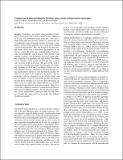| dc.contributor.author | Melo, Gabriela | |
| dc.contributor.author | Malcolm, Alison E. | |
| dc.contributor.author | Fehler, Michael | |
| dc.contributor.other | Massachusetts Institute of Technology. Earth Resources Laboratory | |
| dc.date.accessioned | 2014-10-01T12:53:20Z | |
| dc.date.available | 2014-10-01T12:53:20Z | |
| dc.date.issued | 2012 | |
| dc.identifier.uri | http://hdl.handle.net/1721.1/90502 | |
| dc.description.abstract | Mapping, localization, and general characterization of problems in reservoir fracture systems is one of the most important in oil, gas, and geothermal energy production. One way to study and monitor these fracture systems is to analyze the microearthquakes triggered during hydraulic fracturing or stimulation, as these events generally occur along newly created and preexisting fractures. Thus, the location of the microseismic events can be used to characterize the properties of the fracture system. There are many different methods for localizing microearthquakes and, in general, these methods yield different locations, velocity models, and event origin times, due to differences in algorithms and input models. This makes it very difficult to know which one gives the most accurate and consistent results in practice. The goal of this work is to use basic concepts from seismic interferometry for estimating constraints on the P and S traveltimes between two microearthquake locations. Information obtained through seismic interferometry pertains to only the Earth parameters between two receivers or, by reciprocity, two sources. This information is also less dependent on the velocity model, and less susceptible to errors in arrival time picking and noise in the data due to averaging over receivers. This information can then be used to evaluate and compare different sets of results obtained through different localization methods. Here we illustrate this comparison method by comparing localization results from two different methods. For our data set, in particular, seismic interferometry cannot give hard constrains but it gives bounds that can be used to asses results from different localization methods. | en_US |
| dc.description.sponsorship | United States. Dept. of Energy (Grant DE-FG36-08GO18197); Massachusetts Institute of Technology. Earth Resources Laboratory (Founding Members Consortium) | en_US |
| dc.language.iso | en_US | en_US |
| dc.publisher | Massachusetts Institute of Technology. Earth Resources Laboratory | en_US |
| dc.relation.ispartofseries | Earth Resources Laboratory Industry Consortia Annual Report;2012-13 | |
| dc.subject | Microseismic | |
| dc.subject | Imaging | |
| dc.subject | Interferometry | |
| dc.title | Comparison of microearthquake locations using seismic interferometry principles | en_US |
| dc.type | Technical Report | en_US |
